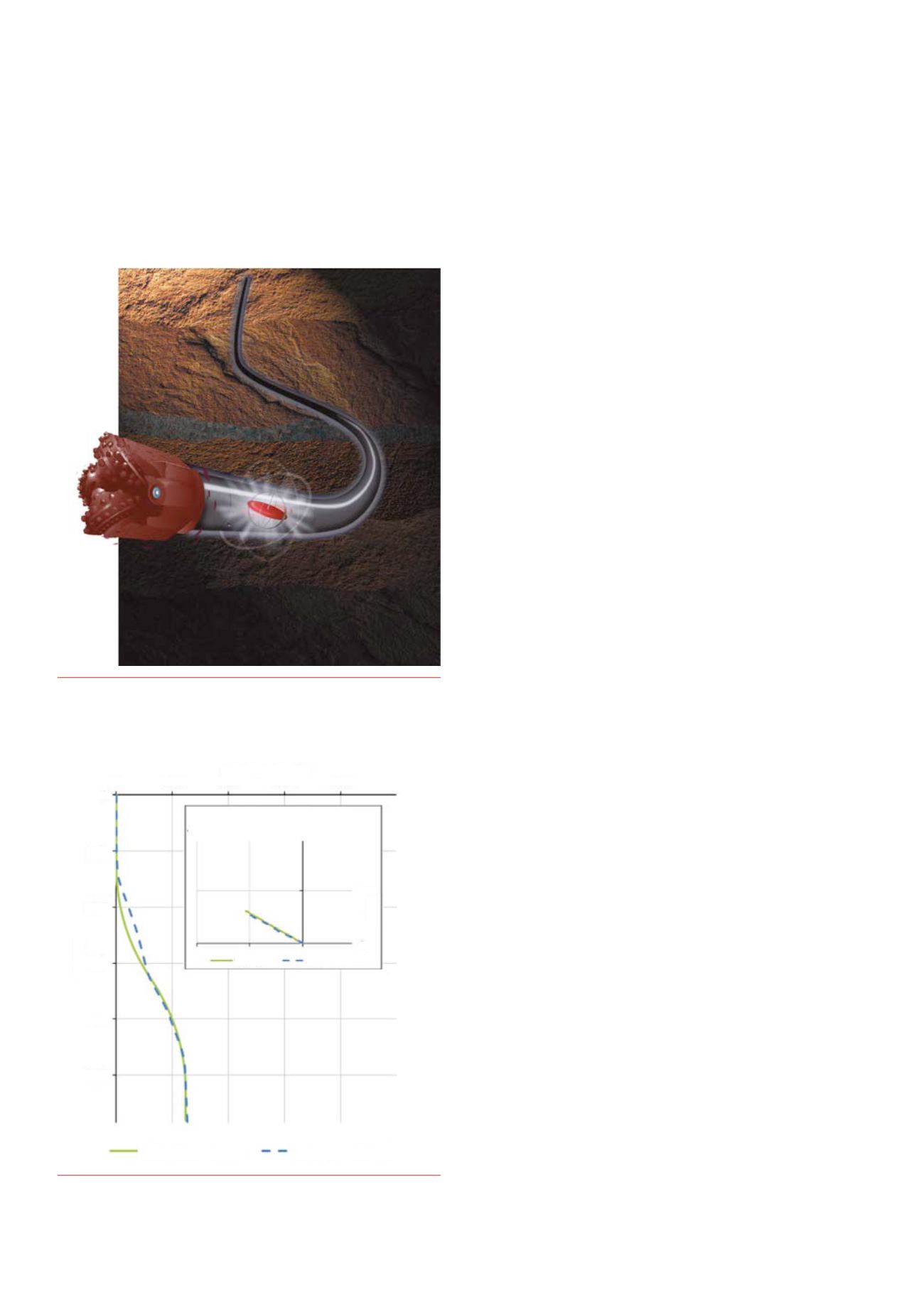
36 |
OilfieldTechnology
February
2014
Inaddition, noaccess roadorpadwasprepared inadvance, due to
the lowmarginsassociatedwith thewells.
Phase1:wellsoverbalancedwithmud
The firstphaseof thecampaignconsistedofdrilling threewells
overbalancedwithmud.OnewellwasanS-curve, and twowells
weredeviated tovaryingextents. Armedwith thePOLARIS tool, the
AnTech teamworked inconjunctionwithaspecialistCTD rigpartner
usingahybrid land rig.Byusingahybriddrilling rig, drilling timecan
be reducedbyup to60%compared todrillingwithaconventional
jointedpipe rig.
The firstwellwasanS-curvewelldrilled tonearly3000ftTVDand
over600ft lateraldisplacement (Figure2).
Theplanned targetwassituatedunderproductive farmland.
AnTechwasable todrill thewellbyplacing the rigonadjacent land
andsetting the trajectoryso that therewouldbenodisruption to the
landowner (Figure3).
The reservoir targets ofWells 2and3were situateddirectly
below creeks, whichmeant that the rigagain couldnot be sited
above the reservoir target, therefore thedecisionwasmade to
drill deviatedwellbores. As a result, efforts toexploit the reservoir
werenot compromised. Followingaone-daymobilisation, the
teamdrilledWell 2 toover 1500 ft TVD, withanaveragedog leg
severityof approximately 7.5˚. Theaccurate steering capabilities
of thePOLARIS tool enabled the job tobe completed in less than
oneday.
For the thirdand finalwell ofPhase1, the team travelledsouth
to thedrillingsitenearGoodland,Kansas. ThePOLARIS tooldrilled
efficientlyalong thedrillingpath (over1100ftTVDand700ft lateral
displacement).Onceagain, theoperationwascompletedon time,
reconfirming theeffectivenessof thesolid-stateAcrobat™gyro
system, theunderlying technology thatmakes itpossible tomonitor
orientationof the tool.
Theuseof agyrosensor inPOLARISmeans that the tool isvery
short (BHA less than40ft). TheAcrobatgyrosensor is located just
behind themotor. Thisgivesquickdirectional feedback,which in turn
meansabetterwell trajectory.
Maximumaccess,minimalimpact.
Thecombineddirectional capabilityandcompactnatureof the
operationsmeant thatPhase1wasexecutedwithminimal impacton
theenvironment.Byusing thismethod, AnTechwasable toaccess
reservoir targets thatwouldnothavebeen feasibleusingvertical
drilling. Thewellsweredrilledundera riverbed, ahill and from the
edgeof acornfield,withoutdisrupting theongoingharvest. Theyalso
tookplace inareaswithnoaccess roadorprepareddrillpads. Low
marginoperationsof this typeareonlyviablewithasolutionof this
nature,whichcanbemobilisedquicklyandefficiently, anddrilled
rapidly.
Phase2:Horizontalwells4and5drilledwithair
The final twowellsweredrilledhorizontallywithair. Thebuild
sectionsof thesewellsweredrilledwithmudusingan8
½
in. bit. The
horizontal sectionsweredrilledwithanairmistusinga6
¼
in. bit. Air
wasused todrill thesewellsdue to thehighly fractured formations,
whichwereunable tosupport thepressureof a liquidcolumn.
Oneof thekeybenefitsof thePOLARIS tool is that itgenerates
reportsofdownholevibration in real time.DuringPhase2, shock
spikesofup to350gwere recordedby theaccelerometersduringair
drilling, or– tobemoreaccurate–with thebitoff-bottom. These
measurementsdemonstrate theneed forequipment that can
withstand theveryhighshockandvibrationenvironment thatoccurs
whendrilling inairorwithaerated fluids.
HorizontalWell 4wasdrilled to1090ftTVDandover1450ft
lateraldisplacement. The team thencarriedout thesecondoperation
onhorizontalWell 5,whichwasdrilled to1096ftTVDwitha lateral
displacementof 1103ft (Figure4).
As in the threepreviousdirectionaldrillingoperations, the
POLARIS tool steeredeasily, reconfirming theeffectivenessof the
Acrobatgyrosystemand itsability todrilldirectional andhorizontal
wells.
Figure1.
Usingsolid-stategyrotechnology,thePOLARISBHAforCTD
offersanaffordablewaytodrilldirectional,S-curveandhorizontalwells
inshallowreservoirs.
Figure2.
Well1,anS-curvedirectionalwelldrilledtonearly3000ftTVD,
wasdrilledunderacornfieldwithoutdisruptingtheharvest.
VerticalSection(ft)
0
0
500
1000
1500
2000
500
1000
1500
2000
2500
NS(ft)
-1000
500
0
WellPlan
SectionView-Planned
SectionView-AsDrilled
Asdrilled
PlanView
TVD(ft)
E-W(ft)
-500
0


